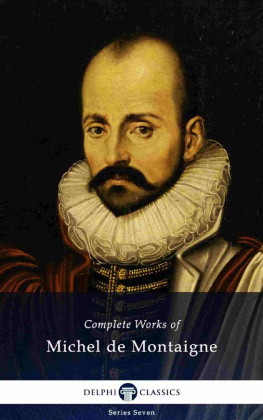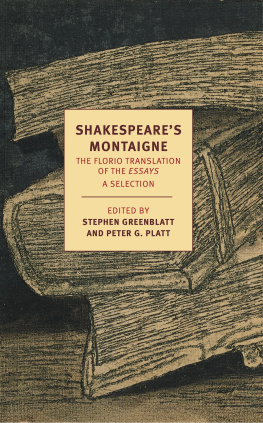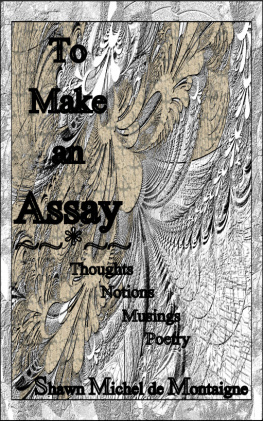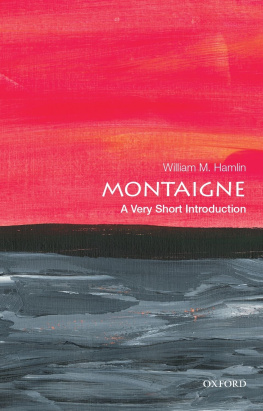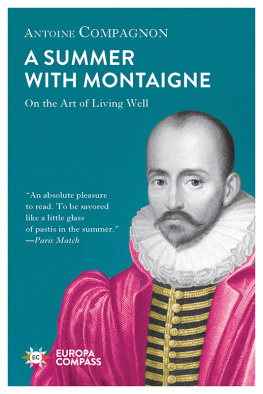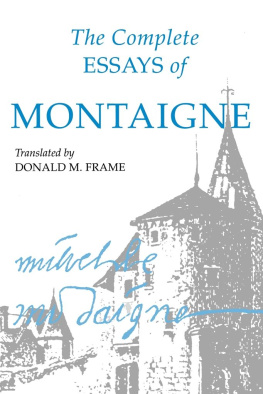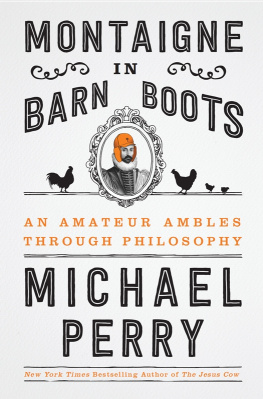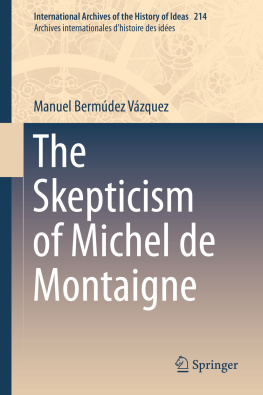The Complete Works of
MICHEL DE MONTAIGNE
(15331592)

Contents

Delphi Classics 2016
Version 1

The Complete Works of
MICHEL DE MONTAIGNE

By Delphi Classics, 2016
COPYRIGHT
Complete Works of Michel de Montaigne
First published in the United Kingdom in 2016 by Delphi Classics.
Delphi Classics, 2016.
All rights reserved. No part of this publication may be reproduced, stored in a retrieval system, or transmitted, in any form or by any means, without the prior permission in writing of the publisher, nor be otherwise circulated in any form other than that in which it is published.
ISBN: 978 1 78656 060 5
Delphi Classics
is an imprint of
Delphi Publishing Ltd
Hastings, East Sussex
United Kingdom
Contact: sales@delphiclassics.com
www.delphiclassics.com
Parts Edition Now Available!

Love reading Michel de Montaigne ?
Did you know you can now purchase the Delphi Classics Parts Edition of this author and enjoy all the novels, plays, non-fiction books and other works as individual eBooks? Now, you can select and read individual novels etc. and know precisely where you are in an eBook. You will also be able to manage space better on your eReading devices.

The Parts Edition is only available direct from the Delphi Classics website.
For more information about this exciting new format and to try free Parts Edition downloads , please visit this link .
The Books

Chteau de Montaigne, Aquitaine, a house built on the land once owned by Montaignes family. His original birthplace no longer exists, though the tower in which he wrote still stands.

The birthplace was almost completely destroyed by fire in 1885, but the tower in which Montaigne worked in his the library escaped the fire and is unchanged since the sixteenth century.

The library where Montaigne wrote many of his Essais.
THE JOURNAL OF MONTAIGNES TRAVELS IN ITALY BY WAY OF SWITZERLAND AND GERMANY IN 1580 AND 1581

Translated and Edited with an Introduction and Notes by W. G. Waters
Montaignes education began in early childhood and followed a rigorous plan that his father had developed by the advice of his humanist friends. Soon after his birth, Montaigne was brought to a small cottage, where he lived the first three years of life in the sole company of a peasant family, in order to, according to the elder Montaigne, draw the boy close to the people, and to the life conditions of the people, who need our help. After these early spartan years, Montaigne was brought back to the family chteau. His father intended that Latin should become his sons first language and his education was assigned to a German tutor (a doctor named Horstanus that could not speak French). His father hired only servants that could speak Latin and they were also given strict orders always to speak to the child in Latin. The same rule applied to his mother, father and servants, who were obliged to use only Latin words he himself employed, allowing him to acquire a thorough knowledge of the language his tutor taught him. Montaignes Latin education was accompanied by constant intellectual and spiritual stimulation. He was familiarised with Greek by a pedagogical method that employed games, conversation and exercises of solitary meditation, rather than the more traditional books.
In 1539 Montaigne was sent to study at a prestigious boarding school in Bordeaux, the Collge de Guyenne, then under the direction of the greatest Latin scholar of the era, George Buchanan, where he mastered the whole curriculum by his thirteenth year. He then began his study of law at the University of Toulouse in 1546 and entered a career in the local legal system. He was a counsellor of the Court des Aides of Prigueux. From 1561 to 1563 he was courtier at the court of Charles IX and he was present with the king at the siege of Rouen (1562). He was awarded the highest honour of the French nobility, the collar of the Order of St. Michael an achievement he had sought from his youth.
In 1578, Montaigne, whose health had always been excellent, began suffering from painful kidney stones, a sickness he had inherited from his fathers family. Throughout this illness, he would have nothing to do with doctors or medicine. From 1580 to 1581, he decided to travel to France, Germany, Austria, Switzerland and Italy, partly in search of a cure, establishing himself at Bagni di Lucca where he took the waters. His journey was also a pilgrimage to the Holy House of Loreto, to which he presented a silver relief depicting himself, his wife and daughter kneeling before the Madonna. During his travels, he kept a fascinating journal recording regional differences and customs and a variety of personal episodes, including the dimensions of the stones he succeeded in ejecting from his bladder. The Journal of Montaignes Travels in Italy by Way of Switzerland and Germany in 1580 and 1581 was published much later in 1774, after its discovery in a trunk found in the authors tower.

Portrait of Michel de Montaigne by Dumonstier, c. 1578
CONTENTS

The original frontispiece
VOLUME I.
PREFACE
UP to February 16, 1581, the Journal of Montaignes travels was written down from dictation by a confidential servant, who seems to have combined the duties of secretary and valet. On the date aforesaid Montaigne either dismissed him or gave him leave of absence, and set to work to keep the diary himself. The portion of the Journal written by the secretary presents certain difficulties in translation, seeing that he wrote sometimes in the first and sometimes in the third person, and occasionally had to describe events which happened in his absence, but as far as possible uniform diction has been secured. In the earlier part Montaigne added divers notes to the margin of the MS. in his own handwriting, thus showing that he revised that portion which he did not write. From May 15, to November 1, 1581, Montaigne used the Italian tongue, reverting to French as soon as he crossed Mont Cenis.
Next page
